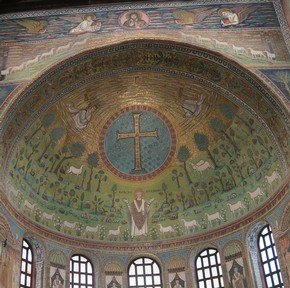Quiz Answer Key and Fun Facts
1. The Roman Empress Regent Galla Placidia (circa 389 - 450) was the daughter of one emperor and the mother of another. This small building, one of the eight World Heritage sites in Ravenna, was built by her in around 430. What is the name of this building?
2. In the south transept of the Mausoleum of Galla Placidia there is a mosaic of an early Christian martyr who is standing beside a gridiron with hot coals underneath. He's now known as the patron saint of cooks, chefs, and comedians! Who is this martyr?
3. In 476 the Ostrogoths took control of Italy and made Ravenna the capital of their Kingdom. The next major monument, the Basilica of Sant'Appolinare Nuovo, was built by King Theoderic the Great in about 500 as part of his new palace. The Ostrogoths subscribed to a Christian doctrine dating to about 300 that was regarded as heretical - what was this belief? Don't confuse it with a racial theory promulgated by the Nazis!
4. The interior of the Basilica of Sant'Appolinare is covered with mosaics illustrating scenes from the life of Christ, the martyrs, and the saints. One mosaic in particular depicts three men - what are their names?
5. The next major monument was built by King Theoderic in about 520 and lies just outside the city walls. What is it called?
6. King Theoderic was interred in this stone tomb when he died in 526. The purple-red stone from which it is made was very rare and highly prized in the ancient world as a symbol of royalty. What is the name of this rock?
7. The Byzantine general Belisarius invaded Italy in 535 and by 540 had taken Ravenna. Local bishops immediately embarked upon a building program of churches in the city, the greatest of which is the one pictured here. It boasts the largest and best-preserved mosaics outside of Istanbul. What is the name of this spectacular, awe-inspiring church?
8. On the right-hand side of the apse in San Vitali is a large mosaic panel completed in 547. In the middle of the panel is shown a man wearing an imperial purple cloak who was the Emperor of the Eastern Roman Empire at that time. Who was he?
9. On the left-hand side of the apse in San Vitali is another large mosaic panel completed in 547. Who was the woman with the halo and the purple imperial cloak?
10. The Chapel in the Bishop's Palace dates to about 495, and in the small museum beside it is this wonderful object: a full-sized Bishop's throne. From what material is it made?
Source: Author
Southendboy
This quiz was reviewed by FunTrivia editor
ponycargirl before going online.
Any errors found in FunTrivia content are routinely corrected through our feedback system.
